The Historic Ganjali Khan Complex in Kerman
The Ganjali Khan Complex, a masterpiece of Safavid-era architecture, combines a bathhouse, bazaar, and mosque, reflecting the grandeur of Kerman's historical heritage.
The Safavid dynasty left its mark on Iran’s architectural history, and nowhere is this more beautifully evident than in the Ganjali Khan Complex of Kerman. Encompassing 11,000 square meters in the heart of the city, this remarkable structure was built under the guidance of the esteemed governor Ganjali Khan, forms an integral part of Kerman’s historic fabric.
The complex’s harmonious design, from its four rectangular gardens to the central circular pool, creates a serene and perfectly balanced atmosphere that leaves an indelible impression.
Walking through the Ganjali Khan Complex, visitors are drawn in by the stunning details of Ganjali Khan Square, the peaceful ambiance of the Ganjali Khan Mosque, the rich Persian heritage within the Ganjali Khan Hammam, and the historical significance of the caravanserai and school.
This masterpiece, crafted by the master architect Sultan Mohammad from Yazd, showcases the pinnacle of Iranian architecture and urban planning. It’s as if the Safavids intended to build not just structures but lasting emotions, pulling us back to a time of artistry and devotion.
In this blog, we’ll explore every element of the Ganjali Khan Complex, providing you with everything you need to know to appreciate its architectural beauty, historical importance, and cultural significance. So if you're on one of our Kerman tours and considering visiting Ganjali Khan Complex, this article is for you.
Who is Ganjali Khan?
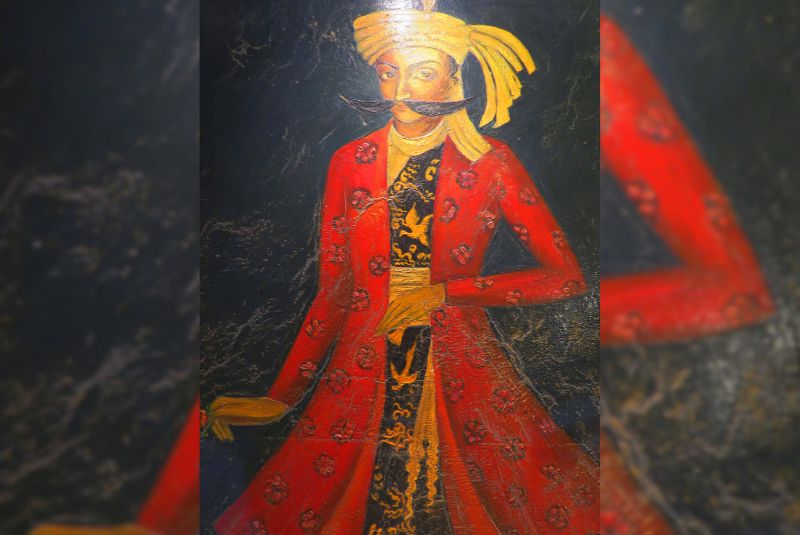
Ganjali Khan was a devoted military leader during the Safavid era, known for his loyalty to Shah Abbas. When summoned by the Shah, he rose to prominence and became the governor of Kerman, where he left a significant architectural legacy.
Rather than settling for the modest structures typical of the time, Ganjali Khan embarked on the ambitious project of building the grand Ganjali Khan Complex. This remarkable collection of structures—bearing his name—reflects his dedication to Kerman’s development and prosperity.
For nearly 30 years, Ganjali Khan faithfully served Kerman, not only by promoting the city’s architecture but also by balancing its politics, economy, and society. His architectural vision is best showcased in the Ganjali Khan Complex, constructed between 1005 and 1034 AH (circa 1596–1625 AD). This complex became a cultural and social hub, featuring a mosque, hammam, square, caravanserai, and more.
While some of these structures have been lost over time—particularly during Agha Mohammad Khan Qajar’s invasions, when many Safavid-era buildings were destroyed—much of Ganjali Khan’s legacy has endured. Today, the Ganjali Khan Complex stands as a testament to his influence and a symbol of Kerman’s rich Safavid heritage.
Different Sections of Ganjali Khan Complex
The Ganjali Khan Complex in Kerman includes several remarkable sections that reflect the architectural mastery of its era. Notable highlights are its two clocks: a circular one above the entrance painted in blue and yellow, with its yellow shade dating back to the Qajar period, and a traditional sundial that tells Kerman’s local time by the shadow of its pointer.
The complex itself was crafted by the skilled architect Sultan Mohammad and it features the Ganjali Khan Hammam, Mosque, Square, and School. Below we have mention every section in detail:
Ganjali Khan Caravanserai and School
Originally, the school within the Ganjali Khan Complex served as one of Kerman’s most renowned seminaries, featuring a four-iwan (arched hall) structure for students.
Located on the eastern side of Ganjali Khan Square, it evolved from a school into a seminary and, eventually, into a caravanserai. Built between 1007-1021 AH (977-991 SH), it unfortunately faced destruction at the hands of Agha Mohammad Khan Qajar, whose actions left a lasting impact on this architectural marvel.
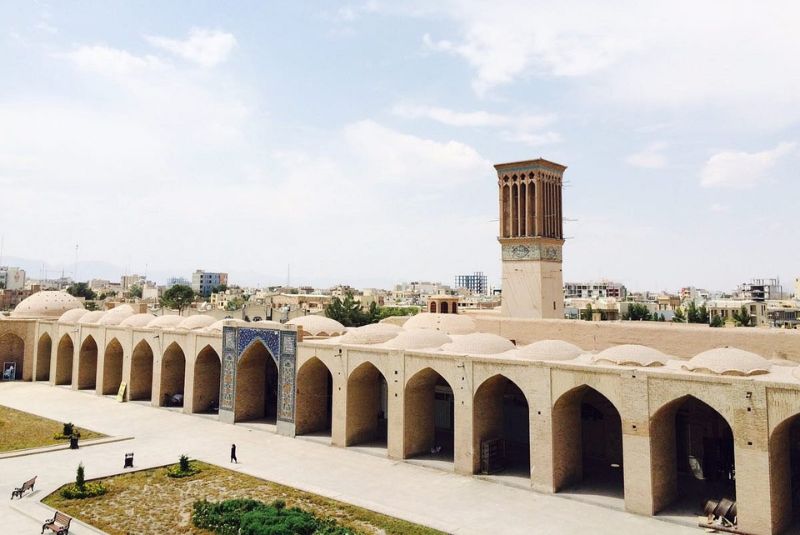
Despite this history, the Ganjali Khan School and Caravanserai found new life as the Faculty of Arts at Shahid Bahonar University of Kerman, preserving the vibrant patterns and bold colors that still captivate visitors today. The interior walls and entrance of the caravanserai display stunning blue, red, and yellow artwork, with intricate patterns that reflect Persian artistic mastery.
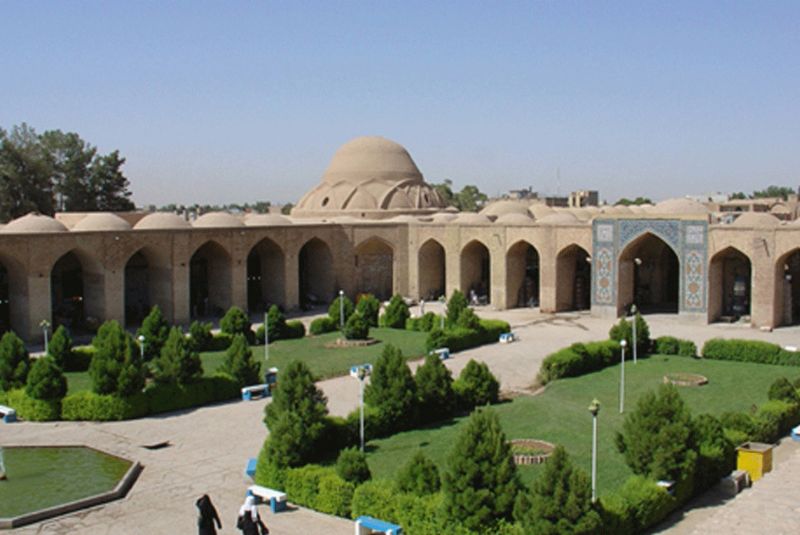
The caravanserai itself was once a lively rest stop for weary travelers. With its beautifully painted doors, blue, white, and brown walls, and welcoming interiors, it offered a place for visitors to rest, refresh, and enjoy food and drink.
The year of its construction, 1007 AH (977 SH), is inscribed on a tile, marking its origin in the Safavid era. Although the complex suffered during the Qajar period, it was registered as a national heritage site on December 20, 1937, to preserve its cultural significance.
Ganjali Khan Mosque
The Ganjali Khan Mosque, while not as vast as some other mosques of its time, boasts a simple iwan design with elegant geometric patterns on plasterwork, serving as a prayer space for both the caravanserai and school.
Despite its modest size, the mosque’s decorations—including fine calligraphy, woodworking, and plaster carvings—are mesmerizing, drawing visitors in with their intricate beauty.
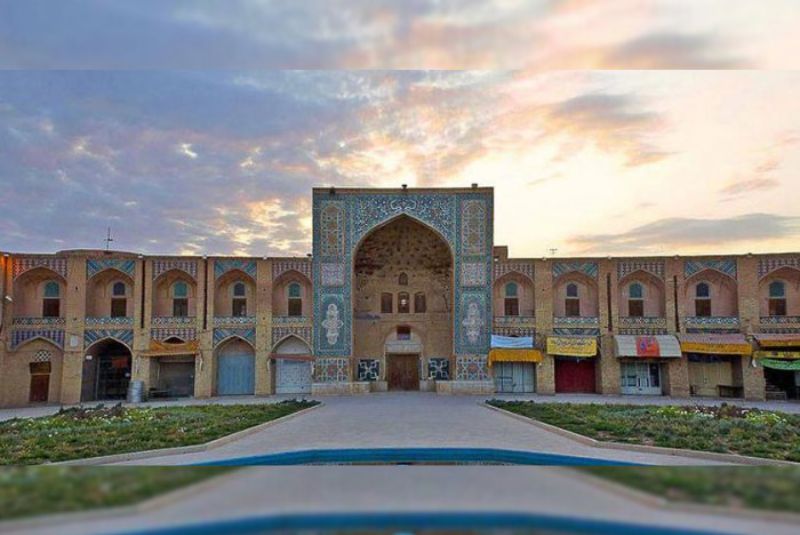
Inside, the mosque’s sanctuary displays splendid paintings, plaster moldings, and a muqarnas dome that adds to its charm. Built in 1007 AH (977 SH) on the northeastern side of the square, the mosque was a space of tranquility for the people of Kerman.
A narrow hallway connects the mosque entrance with its iwan, where visitors were often greeted with beautiful paintings and a skylight dome featuring 12 openings. These openings served as both light sources and ventilation for the mosque, creating an airy and well-lit prayer space.
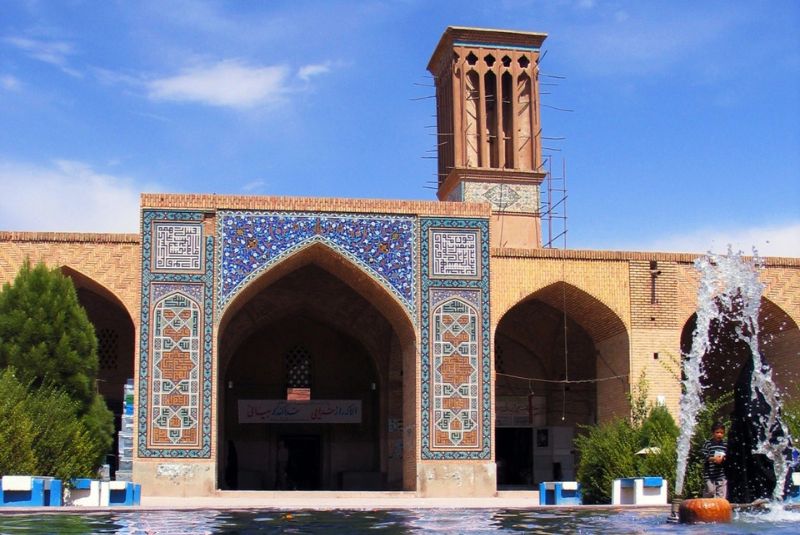
The mosque’s stone-tiled floor and an inscription over its wooden entrance reference Shah Abbas, reading: “Thanks to the grace of Shah Abbas, whose justice made the world a paradise, Ganjali Khan was established as the founder of this mosque devoted to worship.”
The marble mihrab with its vase-shaped carvings adds a delicate touch, while a white stone basin at the entrance once provided water for visitors to quench their thirst or perform ablutions.
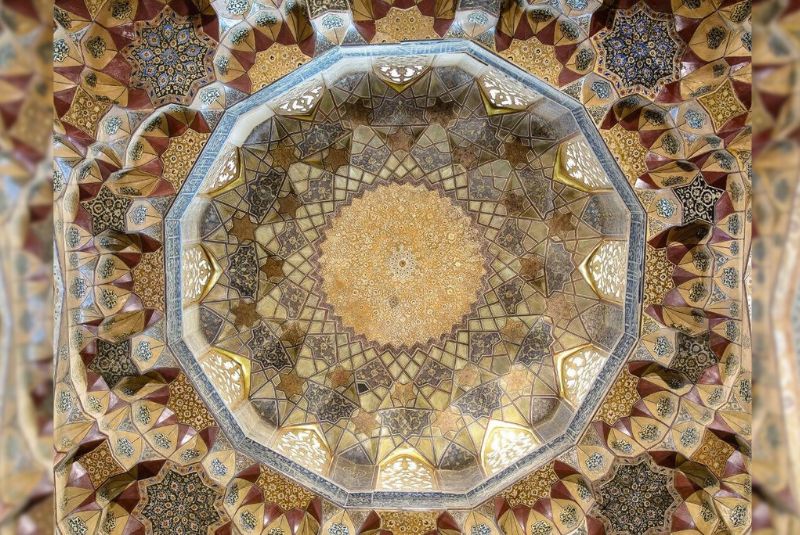
Though the mosque no longer hosts prayers, it stands as a museum of decorative arts. The transformation of the Ganjali Khan Complex into a museum has preserved its historic essence, allowing visitors to appreciate the artistry and spirituality that once defined this space in Kerman.
Ganjali Khan Square
Often compared to Naqsh-e Jahan Square in Isfahan, Ganjali Khan Square spans 101 meters in length and 50 meters in width. Nestled in the city’s center near the bazaar, this square was designed to be expansive, allowing it to host the mosque, bazaar, caravanserai, and bathhouse around its perimeter.
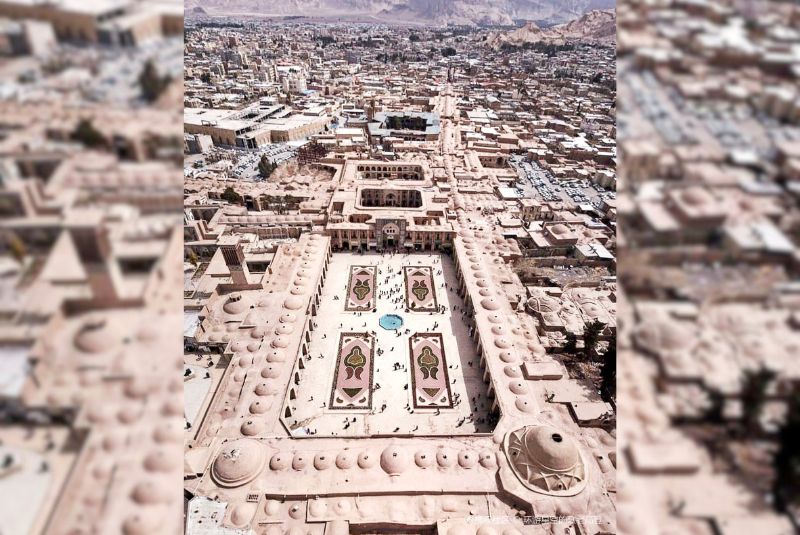
Its positioning close to the Grand Bazaar of Kerman reflects an intention to convey its importance as a public gathering space, almost as if competing with Naqsh-e Jahan to show its "big heart."
While it doesn’t rival Naqsh-e Jahan in size, Ganjali Khan Square holds its own with a similar layout, decorated with intricate tilework, fountains, and beautiful brick arches. This square embodies the principles of traditional Iranian urban planning, with surrounding architectural elements that reflect the aesthetic values of the era.
Constructed in 1611 (990 in the Persian calendar), it stands as an iconic example of Safavid-era urban design, where the square serves as a social and commercial nucleus for the complex.
Ganjali Khan Bazaar
For those who love old, vaulted bazaars, Iran offers a treasure trove, and Ganjali Khan’s Bazaar is no exception. Built in 1597 (975 in the Persian calendar), the bazaar spans only 18 shops, but its length and layout make it one of the most prominent traditional markets in Iran.
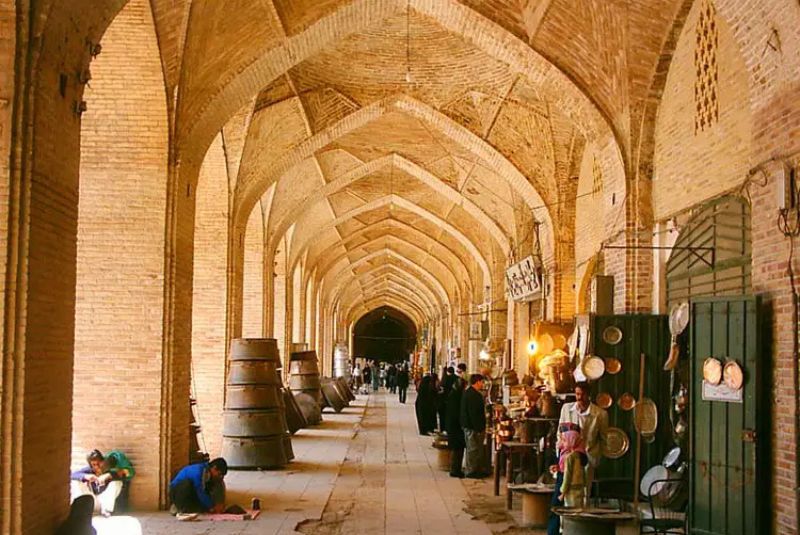
Within its corridors lie the Zargari (Goldsmith) Bazaar and Qeysarieh Bazaar, where locals traded goods for centuries. As you wander through, you’ll be captivated by the tall brick archways, elaborate Iranian designs, and stained glass work that reflects the heritage of traditional Iranian architecture.

The Ganjali Khan Bazaar is filled with stores selling handcrafted goods, spices, textiles, and souvenirs. Featuring 16 arched porticos, a length of 93 meters, and a width of 5.75 meters, the bazaar connects with Kerman’s Grand Bazaar’s fourth section, called Bazaar Ekhtiyari. This bustling marketplace stretches to the Vakil Bazaar entrance, capable of accommodating up to a thousand visitors at a time.
Ganjali Khan Hammam (Bathhouse)
Perhaps one of the most iconic parts of the complex, the Ganjali Khan Bathhouse stands as a masterpiece of Persian bathhouse architecture. The inscription carved in elegant Nasta'liq calligraphy on a green marble tablet reads, "No one in the world has seen a bathhouse like this," reflecting the pride taken in its design. The hammam’s interior walls are painted white with touches of sea-blue, evoking an oceanic feel that mirrors the soothing calm of water.
Built in 1611 (990 in the Persian calendar) by the famous Yazdi architect Sultan Muhammad, the 1,300-square-meter bathhouse offers an immersive experience, reminiscent of the traditional Iranian bathhouses.
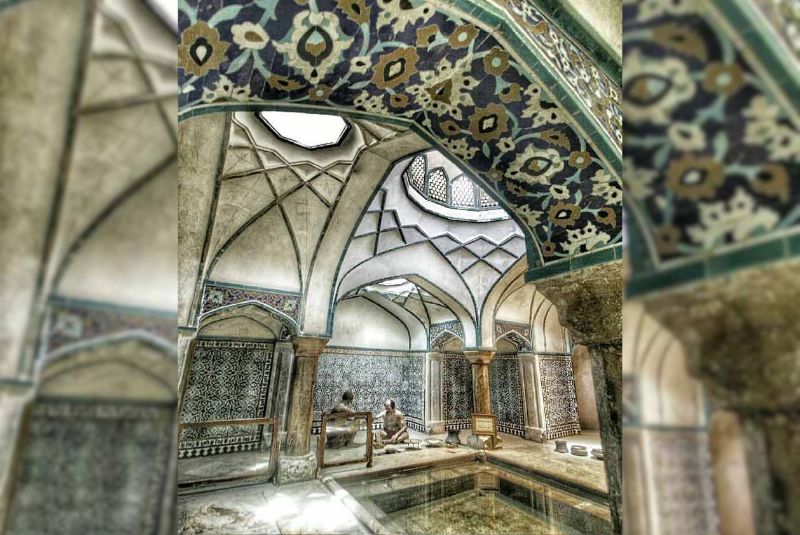
The bathhouse’s atmosphere evokes the energy of yesteryear, with echoes of massage workers providing their services to bathers, from young men softening their bodies for the first time to the more seasoned clientele who sought a vigorous massage.
Featuring intricate plasterwork, the hammam’s main hall stands on beautifully carved columns, solid and imposing, yet light enough to inspire a sense of tranquility.
The bathhouse’s dimensions are remarkable—26 meters in length and 30 meters in width, with an area of 1,300 square meters covering every feature from the changing rooms, plunge pools, and private baths to the entrance corridor and the elaborate portal.
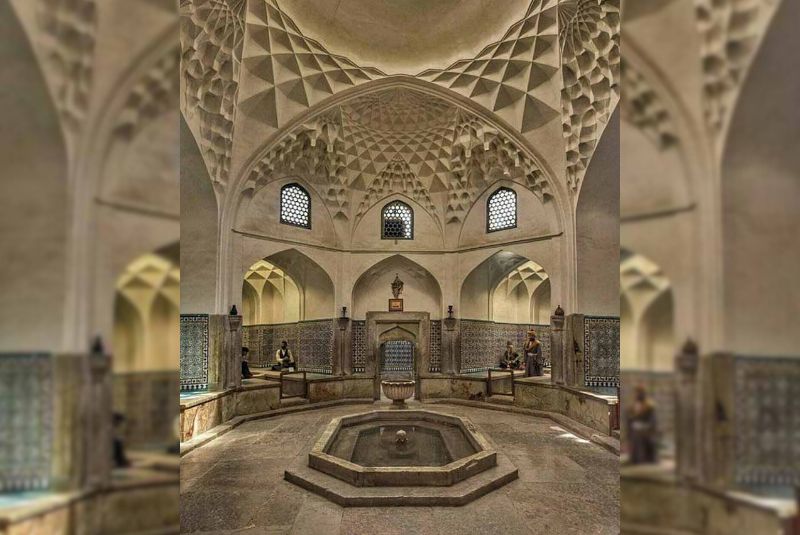
In one corner of the bathhouse, a thick marble slab resembling a full-length mirror with amber-red coloring is embedded in the wall. This slab reflects sunlight into the bathhouse, ensuring bathers don’t lose track of time during their visit.
Adorned with tilework and muqarnas similar to the Safavid-era Ali Qapu Palace, the hammam showcases magnificent ceilings and entryways that capture the elegance of Safavid architectural elements.
Some original Safavid paintings have been restored, while additional decorations from the Qajar period enhance the historical layers. These include paintings depicting stories of Khosrow and Shirin, Bahram Gur, and other fables, creating a narrative that unfolds across the walls. The artwork captivates visitors, offering a silent story woven into the bathhouse’s decoration.
In the dressing areas, mats were thoughtfully placed, stretching from one side of the bath to the other, to allow bathers to dry comfortably. The dressing rooms were designed to ensure privacy, with no line of sight into others’ spaces.
From the dressing area, guests entered a small vestibule where murals of seabirds set the mood for a refreshing bath. Each private booth featured a small basin and fountain for individual use.

In every corner of the bath, essentials like henna, basins, towels, combs, and pumice stones were placed for visitors. Light entered the bathhouse through a skylight called “Gol Jam” or “Mallaqi,” and the bath was heated by the “Golkhani” or furnace system, which maintained the hot steam that was essential for the hammam’s atmosphere.
Today, the Ganjali Khan Bathhouse has been converted into a museum of anthropology, where wax figures created by the University of Tehran’s Fine Arts Faculty in 1973 recreate scenes from the bathhouse’s vibrant past.
Visitors can immerse themselves in the recreated ambiance and get a sense of how people once used the hammam as a social hub, not just a place for bathing. Though it’s been more than 60 years since anyone bathed here, the bathhouse still resonates with echoes of its past, captivating tourists who step into its carefully preserved halls.
The Coppersmith Bazaar
The Coppersmith Bazaar, stretching from east to west and north to south, is one of the most historic sections within the Ganjali Khan Complex. From its entrance in the complex, the market extends to the Kolah Mali Bazaar and retains its original form since the Safavid era.
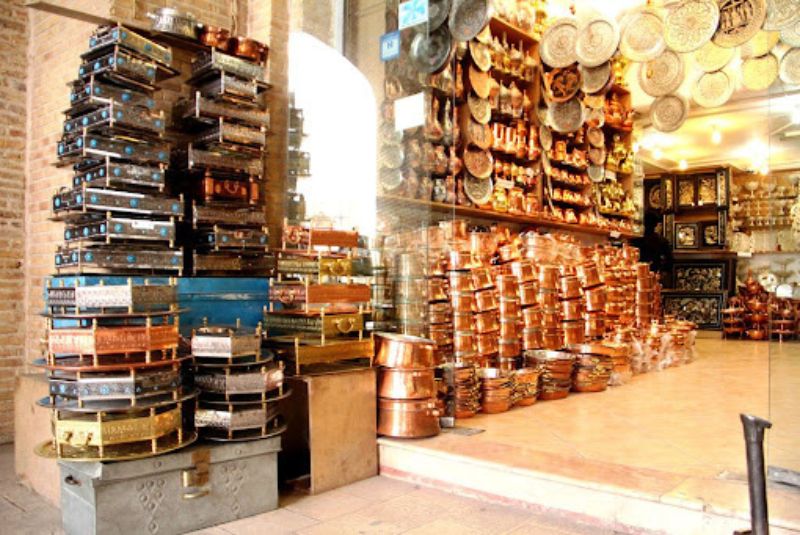
Once a bustling marketplace with barely any room to spare, the bazaar is now a museum, where the mesmerizing sounds of copper clinking enchant visitors. Walking through, one is captivated by the harmony of artisans working with copper—a sound that is both invigorating and nostalgic.
This bazaar is an embodiment of Kerman’s coppersmithing legacy, a craft deeply rooted in the city’s culture. As you enter, you’ll witness rows of copperware displayed by artisans who continue to preserve this ancient craft.
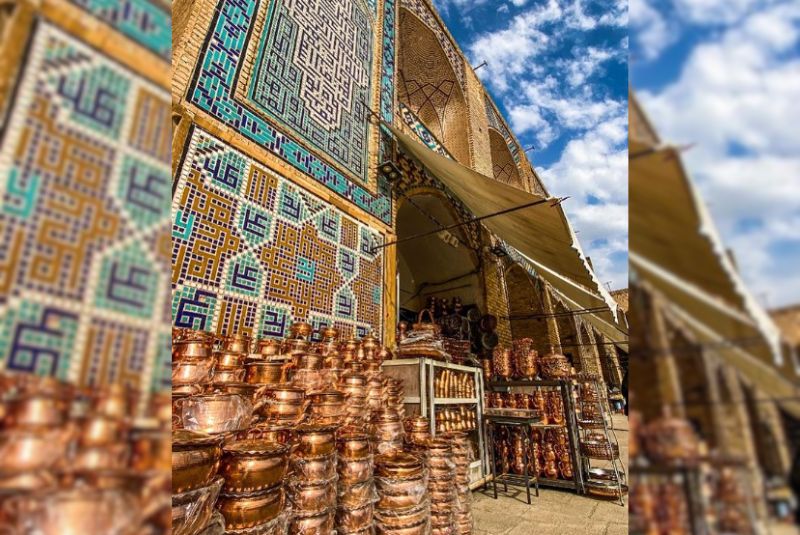
The echoes from the copper shops transport you to an era when the bazaar was teeming with life, filled with merchants and customers bartering for handcrafted goods. From finely carved trays to delicate pots, each piece reflects the artisan’s skill and dedication, creating a unique cultural atmosphere that showcases traditional Iranian craftsmanship.
The Ab Anbar (Water Reservoir)
The Ab Anbar, or water reservoir, within the Ganjali Khan Complex adds both functionality and legacy to this historic site. Ganjali Khan chose to name this reservoir after his son, Alimardan Khan, giving it a personal touch. Built in 1794 (1173 in the Persian calendar), the reservoir served as a source of fresh water for the city’s residents and merchants within the complex.
The architecture of the Ab Anbar is both practical and elegant. It features a staircase that leads down to the water chamber, which is designed with both square and rectangular plans to maximize space.
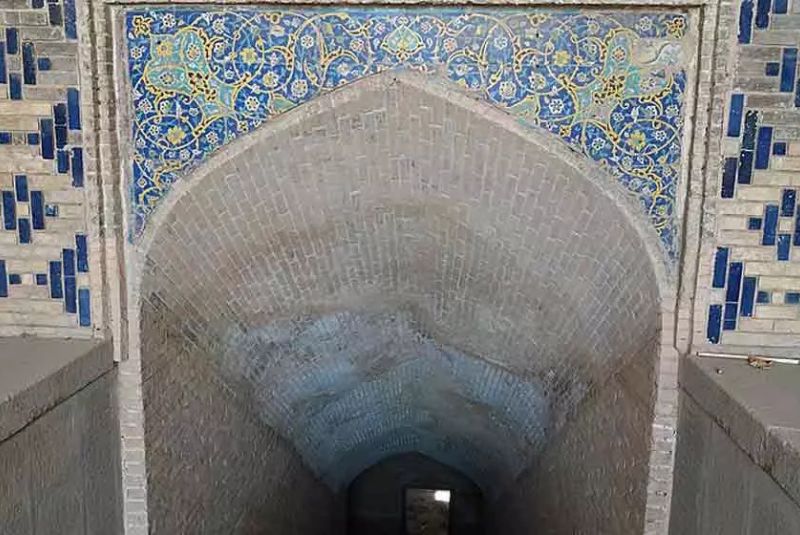
Located directly across from the caravanserai, this reservoir ensured that travelers and merchants had access to fresh water. The facade of the Ab Anbar is adorned with intricate moqarnas (stalactite-like ornamentations) and colorful tilework, enhancing its visual appeal. In recognition of its historical importance, the reservoir was registered as a national heritage site on June 16, 1968.
Visitors to the Ab Anbar can appreciate its cooling effect and architectural design, which reflect the sophisticated water management systems of the Safavid era. The presence of this reservoir in the heart of the complex highlights the foresight in planning to meet the needs of an active, bustling marketplace and offers a glimpse into the daily life of people in that era.
The Mint
The Mint, located on the northern side of Ganjali Khan Square, was constructed between 1598 and 1613 (977–1004 in the Persian calendar). Designed as a domed building, it is supported by four arches with exquisite plasterwork and ornamental brickwork.
This structure was established to produce coins for the Safavid era, filling the complex with the rhythmic sounds of coin-making and instilling a sense of vibrancy and economic stability.
Today, the Mint has been transformed into Iran’s most significant coin museum since 1991. Stepping into the Mint, visitors can imagine the energy of coin production in the Safavid period.
While ancient coins from the Safavid period take center stage, the museum also houses coins from various dynasties, including the Parthian, Sassanian, Zand, Qajar, and Pahlavi periods. This collection offers a timeline of Iran’s rich monetary history, transporting visitors through centuries of craftsmanship and economy.
Each coin represents an era of rulers, trade, and daily life, providing insight into the historical exchange systems that were central to the development of trade routes and economic structures.
The museum’s design preserves the original features of the Mint, allowing modern visitors to appreciate both the aesthetic and historical value of this facility within the Ganjali Khan Complex.
Best Time to Visit Ganjali Khan Complex
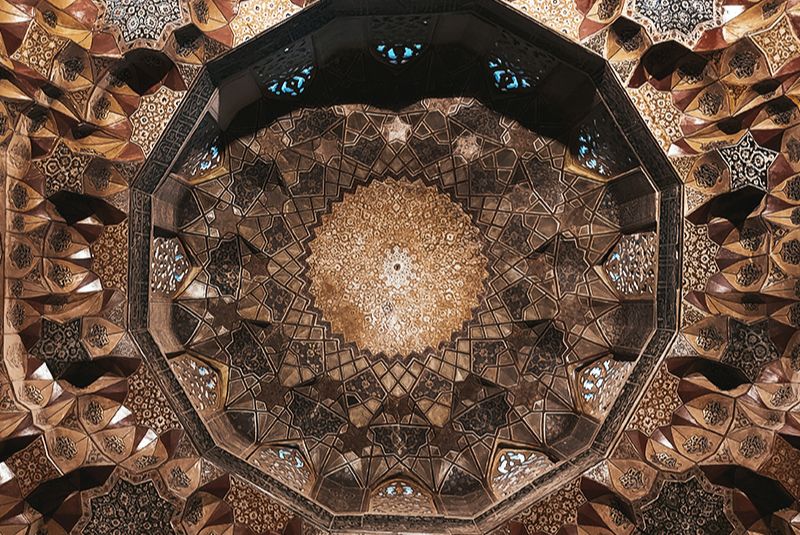
While Kerman’s summers bring intense heat and its winters can be quite chilly, the best time to visit the Ganjali Khan Complex is during spring, especially around Nowruz, the Persian New Year. The mild weather of spring beautifully enhances the complex’s historical charm, transporting visitors back to its days of grandeur.
Ganjali Khan Complex Location and Access
The Ganjali Khan Complex is conveniently located near Shohada Square in Kerman, nestled between two major streets, Imam and Shariati. Visitors can reach it easily by public transportation, with the closest bus stops being Ghods Station and the Northern-Southern Three-Way Station along Shariati Street.
Opening Hours and Ticket Price
The complex is open every day except for certain holidays, and a small entry fee is required for the museum sections. To fully explore all areas of the complex, from the square and bazaar to the bathhouse, you’ll need approximately two hours.
Ganjali Khan Complex Nearby Tourist Attractions
For those interested in exploring more of Kerman's cultural and historical sites, the following landmarks are located within walking distance of the Ganjali Khan Complex:
- Kerman Traditional Bazaar: Just 100 meters away, this vibrant market offers a rich variety of local goods, handicrafts, and spices.
- Bibi Jan Hayati Anthropology Museum: Situated 120 meters from the complex, this museum provides insights into the local culture and traditions.
- Arg Square: Located 300 meters away, Arg Square is another notable historical site worth visiting.
Ganjali Khan Complex Nearby Hotels
Visitors looking to stay close to the Ganjali Khan Complex have several accommodation options, including:
- Amin Hotel Kerman
- Shahbaz Traditional Guesthouse
- Hezar Hotel Kerman
Bottom Line
The Ganjali Khan Complex is one of Kerman’s most captivating historical attractions. Built under Governor Ganjali Khan's vision, this complex features an intricate blend of structures, including a mosque, hammam, square, caravanserai, and bustling bazaar.
Its architectural beauty rivals that of Isfahan’s Naqsh-e Jahan Square, offering a similarly enchanting experience. While we’ve described its architectural features and historical artwork, there’s no substitute for seeing it in person. Visit the Ganjali Khan Complex to fully appreciate its rich history and allure.
Share your story!
Comment below and let us know about your Experience.
Your story inspires others!


Comment
Leave a Comment